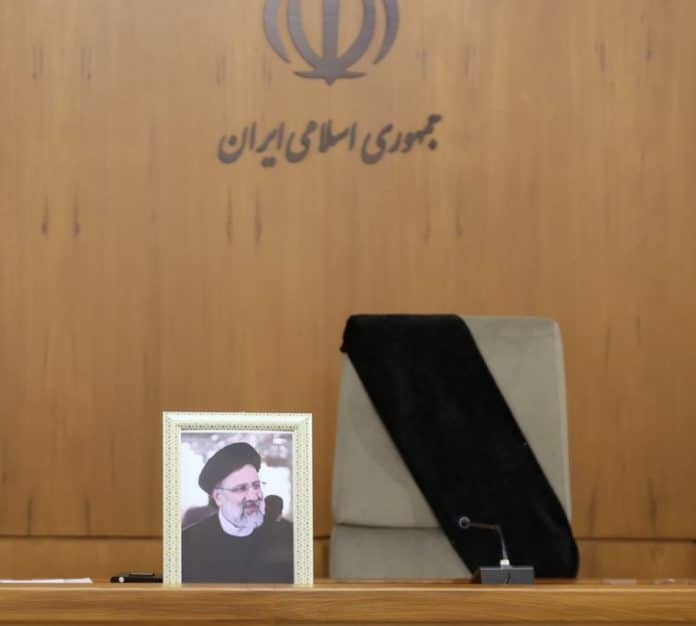Supreme leader Ali Khamenei may want a leader similar to the late fearless Ebrahim Raisi as Iran will hold presidential elections on June 28, following the death of Ebrahim Raisi in a helicopter crash on Sunday.
Vice President Mohammad Mokhber has taken over as Acting President, in keeping with the constitution of the Islamic Republic.
Mr Raisi and eight others, including Foreign Minister Hossein Amirabdollahian, were killed in north-western Iran after their helicopter went down in a mountainous area.
Bad weather and dense fog were to blame, the government said.
Candidates for president can register from May 30 and will be vetted by the Guardian Council, a 12-member body of clerics and jurists that administers elections.
Many Iran analysts have said it’s likely the clerical establishment and supreme leader Ayatollah Ali Khamenei will want a president similar to Mr Raisi, an conservative cleric deeply distrusting of the US and Israel.
In recent elections, the Guardian Council has made it difficult for reformists to stand.
The likely candidates:
Mohammad Mokhber
Born on September 1, 1955, Mr Mokhber, like Mr Raisi, is seen as close to supreme leader Ayatollah Ali Khamenei, who has the last say in all matters of state.
Mr Mokhber became First Vice President in 2021, when Mr Raisi was elected president.
He was part of a team of Iranian officials who visited Moscow in October and agreed to supply surface-to-surface missiles and more drones to Russia’s military, Reuters reported at the time.
The team also included two senior officials from Iran’s Islamic Revolutionary Guard Corps and an official from the Supreme National Security Council.
He had previously been head of Setad, an investment fund linked to the supreme leader.
The fund’s full name is Setad Ejraiye Farmane Hazrate Emam, or the Headquarters for Executing the Orders of the Imam.
In 2010, the EU included Mr Mokhber on a list of individuals and entities it was sanctioning for alleged involvement in “nuclear or ballistic missile activities”.
Two years later, it removed him from the list.
Three years after that, the US Treasury Department added Setad and 37 companies it oversaw to a list of entities upon which Washington imposed sanctions.
Mohammad Bagher Ghalibaf
Born on August 23, 1961, Mr Ghalibaf has been the Speaker of the Iranian parliament since 2020 and was the mayor of Tehran from 2005 to 2017.
He was also formerly Iran’s chief of police from 2000 to 2005 and commander of the Revolutionary Guards’ Air Force from 1997 to 2000.
Should he run in this year’s early elections, it would be his fourth attempt.
In 2013, he was a runner-up to former president Hassan Rouhani.
In 2017, in his third attempt, Mr Ghalibaf withdrew to pave the way for a two-man battle between Mr Rouhani and Mr Raisi.
A former police chief and member of the Revolutionary Guards, he has played on his tough image in the past and campaigned against the wealthy elite, who he called the “four-per-centres”.
Mr Ghalibaf lost momentum in a 2013 election bid after his rival Mr Rouhani said he had proposed allowing student protests in 1999 so that security forces could crush them.

Ali Larijani
Born on June 3, 1957, the former parliament speaker, who held the post from 2008 to 2020, will likely attempt another run.
This will be his second attempt after coming sixth in the 2005 elections when he won 5.83 per cent of the total votes.
Mr Larijani is considered a long-time prominent conservative voice who later allied himself with Iran’s relatively moderate president Rouhani.
A former commander in Iran’s paramilitary Revolutionary Guard, he previously served as the minister of culture and Islamic guidance and as the head of Iran’s state broadcaster.
Under hardline former president Mahmoud Ahmadinejad, he served as secretary of Iran’s powerful Supreme National Security Council for two years, and as a senior nuclear negotiator.
He later became speaker of the Iranian parliament for about 12 years, stepping down when Mr Ghalibaf was elected instead.
Mr Larijani’s family includes prominent members of Iran’s theocracy, with his cleric brother once serving as the head of the Iranian judiciary.
His father was a prominent ayatollah.
Mohammad Javad Zarif
Born on January 7, 1960, in Tehran, Mr Zarif served as Iran’s Foreign Minister from 2013 to 2021.
He was educated in the US and is fluent in English.
His tenure marked a significant period of engagement with the West.
He led Iran’s negotiating team in the landmark Joint Comprehensive Plan of Action (JCPOA) in 2015, aimed at curbing Iran’s nuclear programme in exchange for sanctions relief.
His name has been mentioned in recent weeks after he attended the annual Tehran International Book Fair to present his latest book, The Depth of Patience, where he attracted large crowds.
Mr Zarif has blamed the US sanctions on aviation parts for the crash of the helicopter that killed President Raisi.
“One of the culprits behind yesterday’s tragedy is the United States, because of its sanctions that bar Iran from procuring essential aviation parts,” Mr Zarif said.
Saeed Jalili
Born on September 6, 1965 in the city of Mashhad, Mr Jalili has dedicated his career to serving his country in various capacities.
He holds a PhD in political science and has been a key player in shaping Iran’s foreign policy for decades.
Mr Jalili served as Iran’s chief nuclear negotiator from 2007 to 2013 and led Tehran’s delegation in nuclear talks, earning a reputation for his defence of national interests.
In the 2021 presidential elections, he endorsed hardliner and eventual president, Mr Raisi, after withdrawing only days before election day.
He is currently a member of the Expediency Discernment Council, an administrative advisory body originally set up to resolve differences or conflicts between the parliament and the Guardian Council.
He had also served in the Iran–Iraq War as a member of the Basij volunteers.

















